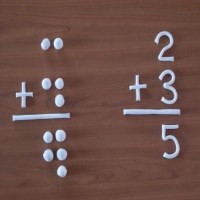Dyslexia and math

Question:
How does dyslexia affect children in math and algebra?
Answer:

Children with dyslexia have difficulty using and understanding symbols and words, especially small function words of language which do not have a meaning that can be easily pictured, or which have multiple meanings depending on concepts. They can also have difficulty with understanding concepts of time, sequence and order.
With mathematics, this leads to confusion both in understanding the symbols commonly used in problems and equations, and in making sense of word problems.
For example, if you ask a child, “how many times does 4 go into 12?” — it is possible that the only words the dyslexic child has heard that make sense are four and twelve. The other words:
how many times does go into
are all words that potentially cause confusion and may be meaningless to that child.
If the child is asked to read that sentence on his own, he might additionally be confused by the numerals, especially 12, as there is a tendency to transpose numbers. That is, to a dyslexic, 12 may look the same as 21.
In algebra, the same problem might be written as,
4 x x = 12 — with the student asked to solve for the value of x
This is an improvement, as there are not as many words to make sense of – but it is still meaningless if the child does not know the meaning of the symbols x and =. Additionally, there is the added confusion of the similarity of appearance between the letter x, used to represent the unknown value, and the use of the x sign for multiplication. The problem with possible transposition of numerals in 12 also remains.
 Most dyslexic children have strong visual and spatial reasoning skills, so they tend to understand math concepts that are taught through manipulative or visual strategies better, although the issues with understanding concepts of time and sequence can still be a barrier. But it would be easier for most if the teacher gave them 12 beads and asked them to divide them into 4 equal groups, and then report how many groups they had.
Most dyslexic children have strong visual and spatial reasoning skills, so they tend to understand math concepts that are taught through manipulative or visual strategies better, although the issues with understanding concepts of time and sequence can still be a barrier. But it would be easier for most if the teacher gave them 12 beads and asked them to divide them into 4 equal groups, and then report how many groups they had.
Because the root cause of the problem is the lack of understanding of particular words, symbols or concepts, each child has their own unique set of barriers. Each, over time, will have learned to recognize some words and symbols, or mastered some concepts, but not others — so each will have their own particularized area of difficulty.
A tutor, classroom teacher, or parent working with a child on a particular area can help simply by keeping in mind that it is often very simple misunderstandings over words and symbols that are the root of the problem. That is, often the child cannot provide an answer simply because she does not fully understand what is being asked.
(Answer by Abigail Marshall)

